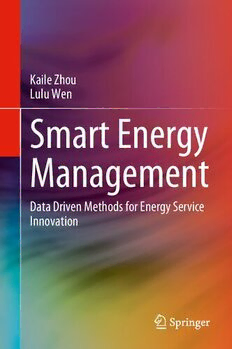Table Of ContentKaile Zhou
Lulu Wen
Smart Energy
Management
Data Driven Methods for Energy Service
Innovation
Smart Energy Management
·
Kaile Zhou Lulu Wen
Smart Energy Management
Data Driven Methods for Energy Service
Innovation
KaileZhou LuluWen
SchoolofManagement SchoolofManagement
HefeiUniversityofTechnology HefeiUniversityofTechnology
Hefei,Anhui,China Hefei,Anhui,China
ISBN978-981-16-9359-5 ISBN978-981-16-9360-1 (eBook)
https://doi.org/10.1007/978-981-16-9360-1
©TheEditor(s)(ifapplicable)andTheAuthor(s),underexclusivelicensetoSpringerNature
SingaporePteLtd.2022
Thisworkissubjecttocopyright.AllrightsaresolelyandexclusivelylicensedbythePublisher,whether
thewholeorpartofthematerialisconcerned,specificallytherightsoftranslation,reprinting,reuse
ofillustrations,recitation,broadcasting,reproductiononmicrofilmsorinanyotherphysicalway,and
transmissionorinformationstorageandretrieval,electronicadaptation,computersoftware,orbysimilar
ordissimilarmethodologynowknownorhereafterdeveloped.
Theuseofgeneraldescriptivenames,registerednames,trademarks,servicemarks,etc.inthispublication
doesnotimply,evenintheabsenceofaspecificstatement,thatsuchnamesareexemptfromtherelevant
protectivelawsandregulationsandthereforefreeforgeneraluse.
Thepublisher,theauthorsandtheeditorsaresafetoassumethattheadviceandinformationinthisbook
arebelievedtobetrueandaccurateatthedateofpublication.Neitherthepublishernortheauthorsor
theeditorsgiveawarranty,expressedorimplied,withrespecttothematerialcontainedhereinorforany
errorsoromissionsthatmayhavebeenmade.Thepublisherremainsneutralwithregardtojurisdictional
claimsinpublishedmapsandinstitutionalaffiliations.
ThisSpringerimprintispublishedbytheregisteredcompanySpringerNatureSingaporePteLtd.
The registered company address is: 152 Beach Road, #21-01/04 Gateway East, Singapore 189721,
Singapore
Preface
With the increasing penetration of new generation information technologies and
newconceptsinenergysystem,suchasInternetofThings(IoT),bigdataanalytics,
artificial intelligence, and blockchain, the traditional physical energy system is
being transformed into a smart and interconnected energy ecosystem. Digital-
ization, intellectualization, interconnection, interaction, openness, comprehensive-
ness,decentralization,decarbonization,andpersonalizationaresomeofthetypical
characteristicsofsmartenergysystem,alsoknownastheEnergyInternet.
The transformation of energy system brings many new opportunities and chal-
lengesforsmartenergymanagement.First,theboundaryofthesmartenergysystem
isbeingbroken.Besidesthetraditionalpowergeneration,transmission,transforma-
tion, distribution, and consumption stages, the smart energy system is integrating
awiderrangeofelements.Smartgreenbuilding,smartgreentransportation,smart
greenfactory,andsmartgreenindustrialparkareallinterconnectedwithsmartenergy
system.Second,thescopeofenergyresourcesisincreasinglyexpanding.Forpower
generationresources,itnotonlyincludestraditionalthermalpower,hydropower,and
nuclearpower,butalsoallkindsofnewenergyresources,suchaswindpowerand
solarpower.Moreover,alltypesofenergystoragedevicesandelectricvehicles(EVs)
areemergingenergyresourcesinsmartenergysystem.Third,themulti-sourceand
heterogeneousdataisanewkindofkeyresourceforachievingsmartenergymanage-
ment.Indigitalizedsmartenergysystem,energybigdataincludebothinternaland
externaldata.Thesourcesandformsofenergybigdataarevariousandcomplex,with
rapid growth in scale. Data-driven decision making is a critical tool in supporting
various smart energy management tasks. Finally, the demand for energy services
is more diversified, personalized, and flexible in smart energy environment. Both
supplysideanddemandsidemanagementofsmartenergysystemneedmoreinno-
vative energy services. On the supply side, data-driven decision making can play
an important role in achieving more efficient, flexible, and reliable management
of microgrid, virtual power plant, energy hub, and EV charging. On the demand
side, more accurate load classification and load forecasting based on data analysis
can support more diversified and personalized integrated energy service, demand
response,andenergyefficiencyimprovement.
v
vi Preface
Therefore, data-driven smart energy management has great significance for the
optimaloperationofsmartenergysystemandachievingthegoalsofenergyservice
innovation.Itisalsoaninevitablewayforthelowcarbontransformationofenergy
system, and peak carbon dioxide emissions and achieve carbon neutrality. To this
end,thisbookintroducesaseriesofstate-of-the-artdata-drivenmethodsandappli-
cations in smart energy management, which can provide ideas for the academic
andindustrialcommunityandencouragefutureresearchanddevelopmentinrelated
areas.
The book is organized in 12 chapters. Chapter 1 introduces the research back-
ground and presents the literature review. It also provides the data-driven smart
energymanagementframework.Chapters2–4mainlyfocusontheloadclassifica-
tionandelectricityconsumptionpatternmining.Chapter2discussestheresidential
electricityconsumptionpatternminingbasedonfuzzyclusteringmodel.Chapter3
investigatestheloadprofilingconsideringshapesimilarityusingshape-basedclus-
teringmethod.Chapter4presentsloadclassificationanddrivenfactorsidentification
based on ensemble clustering method. Chapters 5 and 6 mainly investigate power
demandandloadforecasting.Chapter5studiesthepowerdemandandprobability
densityforecastingbasedondeeplearning.Chapter6presentstheloadforecastingof
residentialbuildingsbasedondeeplearningmodel.Chapters7–9mainlyfocusonthe
differenttypesofdemandresponse.Chapter7proposesanincentive-baseddemand
responsemodelwithdeeplearningandreinforcementlearning.Chapter8provides
a residential electricity pricing model based on multi-agent simulation. Chapter 9
investigates the integrated energy services based on integrated demand response.
Chapter10providesanEVchargingschedulingmodelconsideringdifferentcharging
demands. Chapters 11 and 12 mainly focus on the peer-to-peer (P2P) electricity
trading in energy blockchain environment. Chapter 11 investigates the P2P elec-
tricity trading pricing in energy blockchain environment. Chapter 12 provides a
credit-basedP2Pelectricitytradingmodelinenergyblockchainenvironment.
Tosummarize,thisbookexploresvarioussmartenergymanagementtaskswith
variousdata-drivendecision-makingmethods.Thesmartenergymanagementtasks
include load classification, load forecasting, demand response, integrated energy
service,EVchargingscheduling,andP2Pelectricitytrading.Thedecision-making
methodsincludefuzzyclustering,shape-basedclustering,ensembleclustering,deep
learning, reinforcement learning, multi-agent simulation, game theory model, and
optimizationmodel.Thisbookprovidesanimportantreferencefortheresearchand
developmentofdata-drivenmethodsinsmartenergymanagementandpromotesthe
developmentofsmartenergyindustry.
Hefei,China KaileZhou
November2021 LuluWen
Acknowledgements
Thisbookisasummaryoftheresearchresultsonsmartenergymanagementachieved
byourresearchgroupinrecentyears.Manypeoplecontributedtothisbookinvarious
ways.WewouldliketothankProf.ShanlinYang,Mr.JieChong,Ms.LexinCheng,
Mr. Zhifeng Guo, Ms. Chen Wang, Ms. Yanni Jiang, Ms. Li Sun, Dr. Lanlan Li,
Dr. Xinhui Lu, Dr. Tao Ding, Dr. Jun Li, Prof. Jianling Jiao, Dr. Zhen Shao from
HefeiUniversityofTechnology,Prof.XiaolingZhangfromtheCityUniversityof
Hong Kong, Mr. Jiong Zhou and Mr. Linhai Ye from Jizhong Energy Technology
ServiceCo.,Ltd,Mr.HuizhouLiufromStateGridAnhuiElectricPowerCompany,
andsomeothers,fortheircontributiontorelatedresearchprojectsorrelatedworks.
This book is supported in part by the National Natural Science Foundation of
China(71822104)andinpartbytheNaturalScienceFoundationofAnhuiProvince
(2008085UD05).Theauthorsreallyappreciatetheirsupport.
KaileZhou
LuluWen
vii
About This Book
Digitalization, intellectualization, interconnection, interaction, openness, compre-
hensiveness,decentralization,decarbonization,andpersonalizationaresomeofthe
typicalcharacteristicsofsmartenergysystem.Energybigdataresourcesanddata-
driven methods provide new ways for achieving smart energy management. This
book explores various smart energy management tasks with various data-driven
decision-makingmethods.Thesmartenergymanagementtasksincludeloadclassi-
fication,loadforecasting,demandresponse,integratedenergyservice,EVcharging
scheduling,andP2Pelectricitytrading.Thedecision-makingmethodsincludefuzzy
clustering, shape-based clustering, ensemble clustering, deep learning, reinforce-
mentlearning,multi-agentsimulation,gametheorymodel,andoptimizationmodel.
Thisbookprovidesanimportantreferencefortheresearchanddevelopmentofdata-
drivenmethodsinsmartenergymanagementandpromotesthedevelopmentofsmart
energyindustry.
ix
Contents
1 Introduction .................................................. 1
1.1 Background ............................................. 1
1.2 Data-DrivenSmartEnergyManagement ..................... 5
1.2.1 FrameworkofSmartEnergyManagement ............ 5
1.2.2 EnergyBigDataDrivenApplications ................ 6
1.2.3 BusinessandServiceModelInnovation .............. 7
1.3 LiteratureReview ........................................ 8
1.3.1 SmartEnergySystemManagement .................. 9
1.3.2 LoadCharacteristicRecognition .................... 11
1.3.3 DemandResponse ................................ 16
1.4 ScopeoftheBook ........................................ 21
References .................................................... 25
2 ResidentialElectricityConsumptionPatternMiningBased
onFuzzyClustering ........................................... 33
2.1 Introduction ............................................. 33
2.2 Methodology ............................................ 34
2.2.1 Clustering ....................................... 34
2.2.2 FCMClustering .................................. 36
2.3 Model .................................................. 37
2.3.1 FuzzifierSelection ................................ 37
2.3.2 ClusterValidation ................................. 38
2.3.3 SearchingCapabilityOptimization .................. 39
2.4 ResultsandDiscussion .................................... 41
2.4.1 Data ............................................ 41
2.4.2 Discussion ....................................... 42
2.4.3 ResultsValidation ................................ 44
2.5 Conclusion .............................................. 46
References .................................................... 47
xi
xii Contents
3 Load Profiling Considering Shape Similarity Using
Shape-BasedClustering ........................................ 51
3.1 Introduction ............................................. 51
3.2 LiteratureReview ........................................ 52
3.3 Data .................................................... 55
3.3.1 DatasetA ........................................ 55
3.3.2 DatasetB ........................................ 55
3.4 FrameworkandMethodology .............................. 55
3.4.1 PrincipalComponentAnalysis ...................... 56
3.4.2 K-meansClustering ............................... 57
3.4.3 DynamicTimeWarping ........................... 58
3.4.4 Shape-BasedClustering ........................... 59
3.5 ResultsandDiscussion .................................... 62
3.5.1 ClusteringwiththeImprovedK-meansAlgorithm ..... 62
3.5.2 Shape-BasedPatternRecognition ................... 70
3.6 Conclusion .............................................. 75
References .................................................... 76
4 LoadClassificationandDrivenFactorsIdentificationBased
onEnsembleClustering ........................................ 81
4.1 Introduction ............................................. 81
4.2 Methodology ............................................ 83
4.2.1 K-meansClustering ............................... 84
4.2.2 SpectralClustering ................................ 84
4.2.3 ConcurrentK-meansandSpectralClustering ......... 85
4.2.4 Multi-NominalLogisticRegression ................. 86
4.3 Data .................................................... 87
4.4 ResultsandDiscussion .................................... 87
4.4.1 LoadClassificationResult ......................... 87
4.4.2 Different Load Patterns in Weekdays
andWeekends .................................... 90
4.4.3 InfluenceFactors ................................. 93
4.5 Conclusion .............................................. 97
References .................................................... 97
5 PowerDemandandProbabilityDensityForecastingBased
onDeepLearning ............................................. 101
5.1 Introduction ............................................. 101
5.2 DeepLearningModel ..................................... 104
5.2.1 PowerDemandForecasting ........................ 105
5.2.2 PowerDemandProbabilityDensityForecasting ....... 109
5.3 CaseStudy .............................................. 112
5.3.1 Data ............................................ 112
5.3.2 FeatureEngineering ............................... 112
5.3.3 CaseStudy1 ..................................... 113
5.3.4 CaseStudy2 ..................................... 120

